HOG-ESRs Face Emotion Recognition Algorithm Based on HOG Feature and ESRs Method
Abstract
:1. Introduction
- Based on [8], an ensemble with shared representations method is proposed, four network branches are used, and each branch is based on the original pixel data features and HOG features;
- The new algorithm model is not only based on the original pixel data features of the data set, HOG features are added in the last layer of each branch of the convolution layer. Finally, the extracted mixed feature set is sent to the FC (Fully Connected) layer for calculation;
- According to the results of five and six convolution layers explored by CNN (Convolutional Neural Networks) in [9], the recognition accuracy is not improved. It is found that the model with four convolution layers and two FC layers is the optimal network model for the FER2013 dataset. Therefore, the CNN model with four convolution layers and two FC layers is used in the network branch of the HOG-ESRs model.
2. Related Works
3. Methods
3.1. HOG Features
3.1.1. Gradient Calculation
3.1.2. Calculation of Amplitude and Direction
3.1.3. Unit Quantization
3.1.4. Block Normalization
3.2. ESRs (Ensembles with Shared Representations)
| Algorithm 1: Training ESRs. |
| initialize the shared layers with θshared |
| forbtomaximum ensemble sizedo |
| initialize the convolutional branch Bb with θb |
| add the branch Bb to the network ESRs |
| sample a subset D’ from a training set D |
| foreachmini-batch (xi.yi)~D’do |
| perform the forward phase |
| initialize the combined loss function Lesr to 0.0 |
| foreachexisting branch Bb’ in ESRdo |
| compute the loss Lb’ with respect to Bb’ |
| add Lb’ to Lesr |
| end |
| perform the backward phase |
| optimize ESRs |
| end |
| end |
3.3. HOG-ESRs
4. Experiments and Analysis
4.1. Dataset and Features
4.2. Experiments
4.3. Results
5. Discussion
6. Conclusions
Author Contributions
Funding
Conflicts of Interest
References
- Bettadapura, V. Face Expression Recognition and Analysis: The State of the Art; CoRR: New York, NY, USA, 2012. [Google Scholar]
- Ding, J.; Chen, K.; Liu, H.; Huang, L.; Chen, Y.; Lv, Y.; Yang, Q.; Guo, Q.; Han, Z.; Ralph, M.A.L. A unified neurocognitive model of semantics language social behaviour and face recognition in semantic dementia. Nat. Commun. 2020, 11, 2595. [Google Scholar] [CrossRef] [PubMed]
- Anagnostopoulos, C.N.; Iliou, T.; Giannoukos, I. Features and classifiers for emotion recognition from speech: A survey from 2000 to 2011. Artif. Intell. Rev. 2015, 43, 155–177. [Google Scholar] [CrossRef]
- Dobs, K.; Isik, L.; Pantazis, D.; Kanwisher, N. How face perception unfolds over time. Nat. Commun. 2019, 10, 1258. [Google Scholar] [CrossRef] [PubMed] [Green Version]
- Kumar, M.P.; Rajagopal, M.K. Detecting facial emotions using normalized minimal feature vectors and semi-supervised twin support vector machines classifier. Appl. Intell. 2019, 49, 4150–4174. [Google Scholar] [CrossRef]
- Siddiqi, M.H. Accurate and robust facial expression recognition system using real-time youtube-based datasets. Appl. Intell. 2018, 48, 2912–2929. [Google Scholar] [CrossRef]
- Navneet, D.; Triggs, B. His-tograms of oriented gradients for human detection. In Proceedings of the IEEE Computer Society Conference on Computer Vision and Pattern Recognition (CVPR), Washington, DC, USA, 27 June–2 July 2005; Volume 1. [Google Scholar]
- Zhao, Y.; Zhang, Y.; Cheng, R.; Wei, D.; Li, G. An enhanced histogram of oriented gradients for pedestrian detection. Intell. Transp. Sys. Mag. IEEE 2015, 7, 29–38. [Google Scholar] [CrossRef]
- Alizadeh, S.; Fazel, A. Convolutional neural networks for facial expression recognition. arXiv 2017, arXiv:1704.06756v1. [Google Scholar]
- Donia, M.M.F.; Youssif, A.A.A.; Hashad, A. Spontaneous facial expression recognition based on histogram of oriented gradients descriptor. Comp. Inform. Ence. 2014, 7, 31–37. [Google Scholar] [CrossRef]
- Wang, S.; Yu, R.; Tyszka, J.M.; Zhen, S.; Kovach, C.; Sun, S.; Huang, Y.; Hurlemann, R.; Ross, I.B.; Chung, J.M.; et al. The human amygdala parametrically encodes the intensity of specific facial emotions and their categorical ambiguity. Nat. Commun. 2017, 8, 14821. [Google Scholar] [CrossRef] [Green Version]
- Fernández-Dols, J.M.; Crivelli, C. Recognition of facial expressions: Past, present, and future challenges. In Understanding Facial Expressions in Communication; Springer: New Delhi, India, 2015; pp. 19–40. [Google Scholar]
- Prylipko, D.; Roesner, D.; Siegert, I.; Guenther, S.; Friesen, R.; Haase, M.; Vlasenko, B.; Wendemuth, A. Analysis of significant dialog events in realistic human–Computer interaction. J. Multimodal User Interf. 2014, 8, 75–86. [Google Scholar] [CrossRef]
- Niese, R. Facial expression recognition based on geometric and optical flow features in colour image sequences. IET Comp. Vis. 2012, 6, 79–89. [Google Scholar] [CrossRef]
- Shan, C.; Gong, S.; Mcowan, P.W. Facial expression recognition based on local binary patterns: A comprehensive study. Image Vis. Comp. 2009, 27, 803–816. [Google Scholar] [CrossRef] [Green Version]
- Wan, C. Facial expression recognition in video sequences. Intell. Control Automat. IEEE 2012, 6, 4766–4770. [Google Scholar]
- Praseeda Lekshmi, V.; SasiKumar Vidyadharan, D.S.; Naveen, S. In Proceedings of the 2008 International Conference on Audio, Language and Image Processing–Analysis of Facial Expressions using pca on Half and Full Faces, Shanghai, China, 7–9 July 2008; pp. 1379–1383.
- Nguyen, B.T.; Trinh, M.H.; Phan, T.V.; Nguyen, H.D. An efficient real-time emotion detection using camera and facial landmarks. In Proceedings of the Seventh International Conference on Information Science & Technology, IEEE, Da Nang, Vietnam, 16–19 April 2017. [Google Scholar]
- Loconsole, C.; Miranda, C.R.; Augusto, G.; Frisoli, A.; Orvalho, V. Real-time emotion recognition novel method for geometrical facial features extraction. In Proceedings of the 2014 International Conference on Computer Vision Theory (VISAPP), IEEE, Lisbon, Portugal, 5–8 January 2014; Volume 1, pp. 378–385. [Google Scholar]
- Palestra, G.; Pettinicchio, A.; Coco, M.D.; Pierluigi Carcagn, I.; Distante, C. Improved Performance in Facial Expression Recognition Using 32 Geometric Features. In Image Analysis and Processing–ICIAP 2015, Proceedings of the International Conference on Image Analysis & Processing, Genoa, Italy, 7–11 September 2015; Springer International Publishing: New York, NY, USA, 2015; pp. 518–528. [Google Scholar]
- Tian, Y.L.; Kanade, T.; Cohn, J.F.; Li, S.Z.; Jain, A.K. Facial expression analysis. In Handbook of Face Recognition; Springer: London, UK, 2005; pp. 247–275. [Google Scholar]
- Mollahosseini, A.; Hasani, B.; Mahoor, M.H. Affectnet: A database for facial expression, valence, and arousal computing in the wild. IEEE Trans. Affect. Comp. 2017, 10, 18–31. [Google Scholar] [CrossRef] [Green Version]
- Keltiner, D.; Ekrman, P. Darwin and facial expression: A century of research in review. In Unemotion, Handbook of Emotions; Lewis, M., Haviland Jones, J.M., Ekman, P., Eds.; Gilford Press: New York, NY, USA, 2000; pp. 236–249. [Google Scholar]
- Ekman, P. Constants across cultures in the face and emotion. J. Pers. Soc. Psychol. 1971, 17, 124–129. [Google Scholar] [CrossRef] [Green Version]
- Ekman, P. Darwin and Facial Expression: A Century of Research in Review; Academic Press Ishk: Cambridge, MA, USA, 2006; p. 1973. [Google Scholar]
- Ekman, P.; Freisen, W.V.; Ancoli, S. Facial signs of emotional experience. J. Personal. Soc. Psyc. 1980, 39, 1123–1134. [Google Scholar] [CrossRef] [Green Version]
- Barsoum, E.; Zhang, C.; Ferrer, C.C.; Zhang, Z. Training Deep Networks for Facial Expression Recognition with Crowd-Sourced Label Distribution, Proceedings of the ICMI 18th ACM International Conference, Tokio, Japan,12-16 November 2016; ACM: New York, NY, USA, 2016; pp. 279–283. [Google Scholar]
- Hewitt, C.; Gunes, H. Cnn-based facial affect analysis on mobile devices. arXiv 2018, arXiv:1807.08775. [Google Scholar]
- Khorrami, P.; Paine, T.L.; Huang, T.S. Do deepneural networks learn facial action units when doing expres-sion recognition? In Proceedings of the IEEE on CVPR–Workshops, Boston, Massachusetts, USA, 11–12 June 2015; Volume 1, pp. 19–27. [Google Scholar]
- Ekman, P. The argument and evidence about universals in facial expressions. In Handbook of Social Psychophysiology; John Weily & Sons Ltd: Hoboken, NJ, USA, 1989; pp. 143–164. [Google Scholar]
- Hamester, D.; Barros, P.; Wermter, S. Face expression recognition with a 2-channel convolutional neural network. international joint conference on neural networks. In Proceedings of the IEEE 2015 International Joint Conference on Neural Networks (IJCNN), Killarney, Ireland, 12–17 July 2015; pp. 1–8. [Google Scholar]
- Xie, S.; Haifeng, H. Facial expression recognition using hierarchical features with deep comprehensive multipatches aggregation convolutional neural networks. IEEE Trans. Multimed. 2018, 21, 211–220. [Google Scholar] [CrossRef]
- Laptev, D.; Savinov, N.; Buhmann, J.M.; Pollefeys, M. TI-POOLING: Transformation-invariant pooling for feature learning in convolutional neural networks. CVPR 2016. IEEE Comp. Soc. 2016, 289–297. [Google Scholar]
- Li, D.; Wen, G.; Li, X.; Cai, X. Graph-based dynamic ensemble pruning for facial expression recognition. Appl. Intell. 2019, 49, 3188–3206. [Google Scholar] [CrossRef]
- Zhang, K.; Huang, Y.; Du, Y.; Wang, L. Facial expression recognition based on deep evolutional spatial-temporal networks. IEEE Trans. Image Proces. Publ. IEEE Signal Proces. Soc. 2017, 26, 4193–4203. [Google Scholar] [CrossRef] [PubMed]
- Sun, N.; Li, Q.; Huan, R.; Liu, J.; Han, G. Deep spatial-temporal feature fusion for facial expression recognition in static images. Pattern Recognit. Lett. 2019, 119, 49–61. [Google Scholar] [CrossRef]
- Li, T.H.S.; Kuo, P.H.; Tsai, T.N.; Luan, P.C. Cnn and lstm based facial expression analysis model for a humanoid robot. IEEE Access PP 2019, 99, 1. [Google Scholar] [CrossRef]
- Grossman, S.; Gaziv, G.; Yeagle, E.M.; Harel, M.; Mégevand, P.; Groppe, D.M.; Khuvis, S.; Herrero, J.L.; Irani, M.; Mehta, A.D.; et al. Convergent evolution of face spaces across human face-selective neuronal groups and deep convolutional networks. Nat. Commun. 2019, 10, 4934. [Google Scholar] [CrossRef]
- Ouyang, X.; Kawaai, S.; Goh, E.G.H.; Shen, S.; Ding, W.; Ming, H.; Huang, D.Y. Audiovisual emotion recognition using deep transfer learning and multiple temporal models. In Proceedings of the 19th ACM International Conference, Glasgow, Scotland, 13–17 November 2017; pp. 577–582. [Google Scholar]
- Jung, H.; Lee, S.; Yim, J.; Park, S.; Kim, J. Joint fine-tuning in deep neural networks for facial expression recognition. In Proceedings of the 2015 IEEE International Conference on Computer Vision (ICCV), Santiago, Chile, 16–17 December 2015; pp. 2983–2991. [Google Scholar]
- Nguyen, T.; Park, E.A.; Han, J.; Park, D.C.; Min, S.Y. Object detection using scale invariant feature transform. In Genetic and Evolutionary Computing; Springer International Publishing: New York, NY, USA, 2014; Volume 238, pp. 65–72. [Google Scholar]
- Dietterich, T.G. Ensemble methods in machine learning. In Multiple Classifier Systems; Springer: Berlin/Heidelberg, Germany, 2000; pp. 1–15. [Google Scholar]
- Hansen, L.K. Neural network ensemble. IEEE Trans Pattern Anal. Mach. Intell. 1990, 12, 993–1001. [Google Scholar] [CrossRef] [Green Version]
- Li, Y.; Zeng, J.; Shan, S.; Chen, X. Occlusion aware facial expression recognition using cnn with attention mechanism. IEEE Trans. Image Proces. IP 2018, 28, 2439–2450. [Google Scholar] [CrossRef]
- Wang, C.Z.; Zhang, L.; Wang, B. Sparse modified marginal fisher analysis for facial expression recognition. Appl. Intell. 2019, 49, 2659–2671. [Google Scholar] [CrossRef]
- Meshgi, K.; Oba, S.; Ishii, S. Efficient diverse ensemble for discriminative co-tracking. In Proceedings of the 2018 IEEE/CVF Conference on Computer Vision and Pattern Recognition, Salt Lake City, UT, USA, 18–23 June 2018. [Google Scholar]
- Seung, H.S.; Opper, M.A.; Sompolinsky, H. Query by committee. In Proceedings of the 5th Workshop on Computional Learning Theory, Pittsburgh, PA, USA, 27–29 July1992; Volume 284, pp. 287–294. [Google Scholar]
- Hinton, G.; Vinyals, O.; Dean, J. Distilling the knowledge in a neural network. Comp. ence. 2015, 14, 38–39. [Google Scholar]
- Shen, Z.; He, Z.; Xue, X. Meal: Multi-modelensemble via adversarial learning. In Proceedings of the AAAI Conference on Artificial Intelligence, New York, NY, USA, 7–12 February 2019. [Google Scholar]
- Siqueira, H.; Magg, S.; Wermter, S. Efficient facial feature learning with wide ensemble-based convolutional neural networks. arXiv 2020. [Google Scholar] [CrossRef]
- Siqueira, H.; Barros, P.; Magg, S.; Wermter, S. An ensemble with shared representations based on convolutional networks for continually learning facial expressions. In Proceedings of the IEEE/RSJ International Conference on IROS, Madrid, Spain, 1–5 October 2018; pp. 1563–1568. [Google Scholar]
- Chollet, F. Deep learning with python and keras. In The Handbook by the Developer of the Keras Library; MITP-Verlag GmbH & Co. KG.: Wachtendonk/Nordrhein-Westfalen, Germany, 2018. [Google Scholar]
- Kamachi, M.; Lyons, M.; Gyoba, J. Japanese Female Facial Expression Database; Psychology Department in Kyushu University: Fukuoka, Japan, 1998. [Google Scholar]
- Valstar, M.F.; Pantic, M. Induced disgust, happiness and surprise: An addition to the MMI facial expression database. Proc.intern.workshop on Emotion Corpora for Research on Emotion & Affect. 2010, pp. 65–70. Available online: http://lrec.elra.info/proceedings/lrec2010/workshops/W24.pdf#page=73 (accessed on 29 January 2021).
- Gehrig, T. Action unit intensity estimation using hierarchical partial least squares. In Feminist Theory and Literary Practice; Foreign Language Teaching and Research Press: Beijing, China, 2015; pp. 1–6. [Google Scholar]
- Gao, W.; Cao, B.; Shan, S.; Chen, X.; Zhou, D.; Zhang, X.; Zhao, D. The cas-peal large-scale chinese face database and baseline evaluations. IEEE Trans. Syst. Man Cybern. Part A Syst. Hum. 2007, 38, 149–161. [Google Scholar]
- Lucey, P.; Cohn, J.F.; Kanade, T.; Saragih, J.; Matthews, I. The extended Cohn-Kanade dataset (CK+): A complete dataset for action unit and emotion-specified expression. In Proceedings of the 2010 IEEE Computer Vision & Pattern Recognition–Workshops, San Francisco, CA, USA, 13–18 June 2010. [Google Scholar]
- Sauter, D.A.; Eisner, F.; Ekman, P.; Scott, S.K. Cross-cultural recognition of basic emotions through emotional vocalizations. Proc. Natl. Acad. Sci. USA 2015, 112, E3086. [Google Scholar] [CrossRef] [PubMed] [Green Version]
- Lyons, M.J.; Kamachi, M.; Gyoba, J. The Japanese female facial expression. (JAFFE) Database J. 1997, 1–25. [Google Scholar] [CrossRef]
- Ullman, S. Using neuroscience to develop artificial intelligence. Science 2019, 363, 692–693. [Google Scholar] [CrossRef] [PubMed]
- Miao, S.; Xu, H.; Han, Z.; Zhu, Y. Recognizing facial expressions using a shallow convolutional neural network. IEEE Access 2019, 7, 78000–78011. [Google Scholar] [CrossRef]
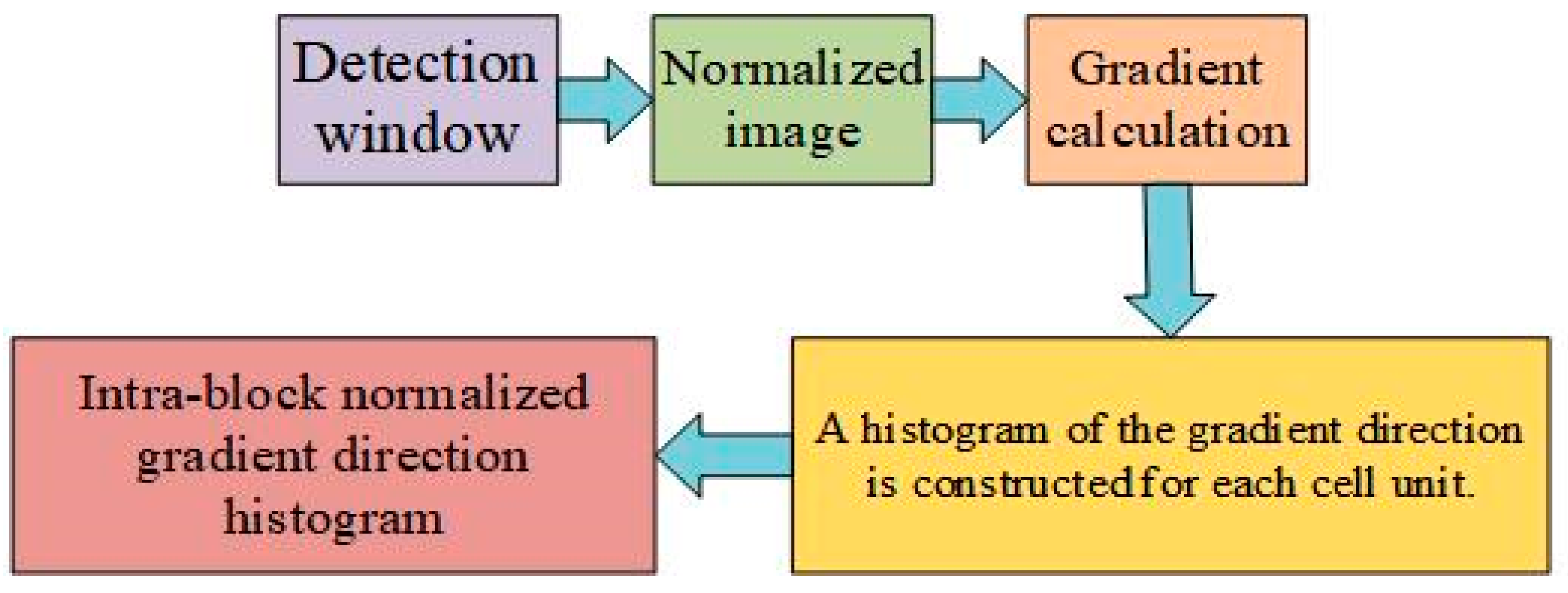
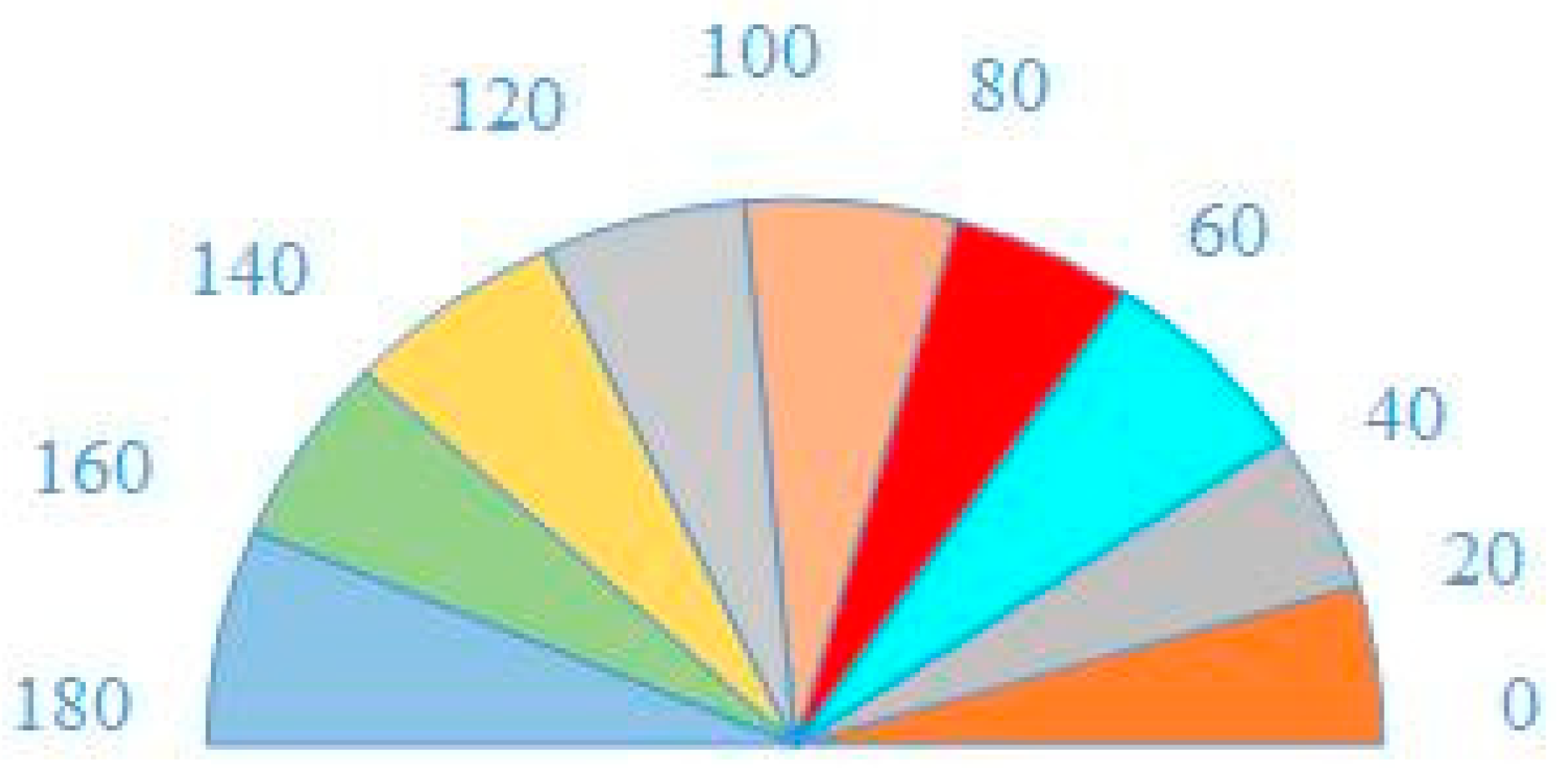
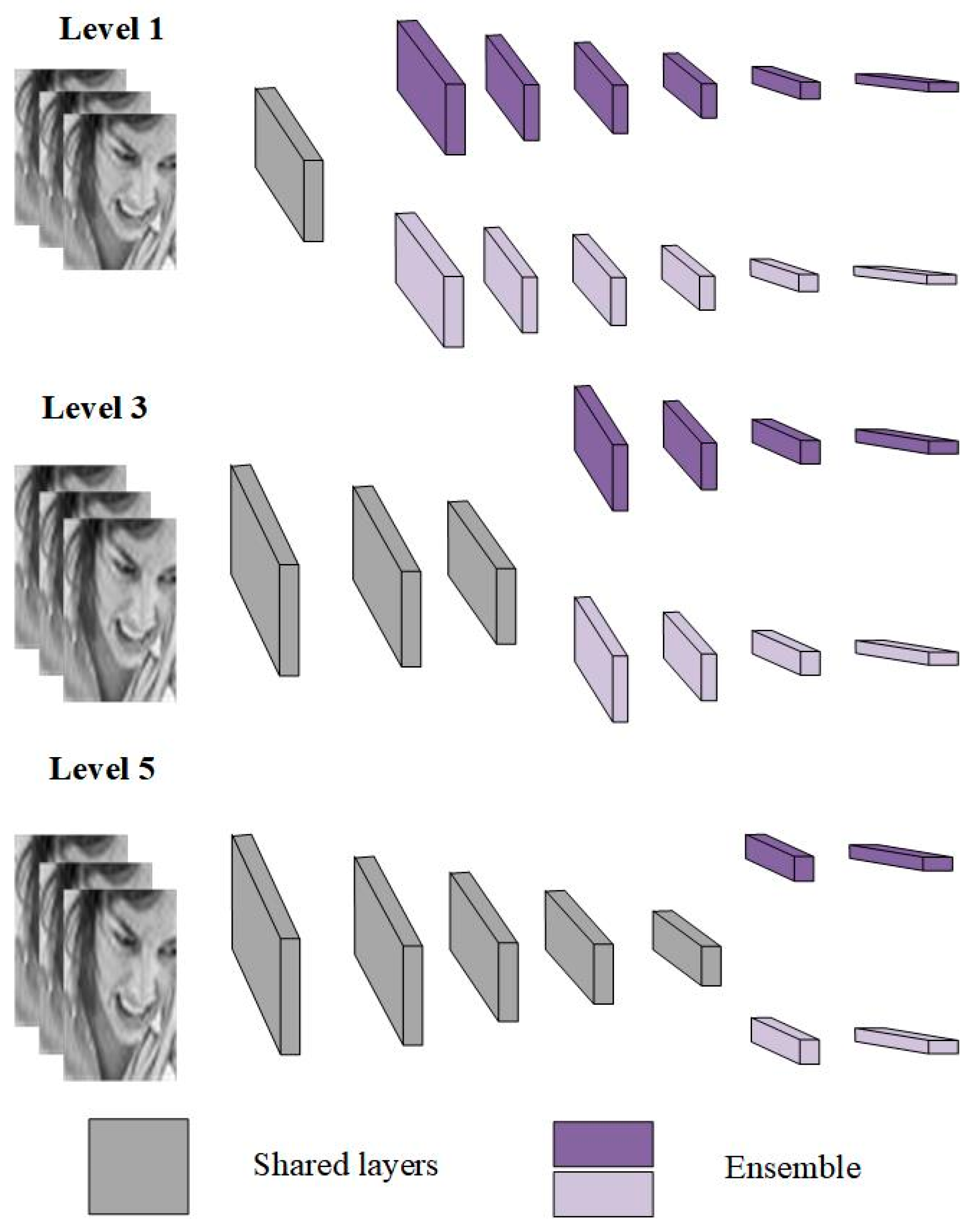
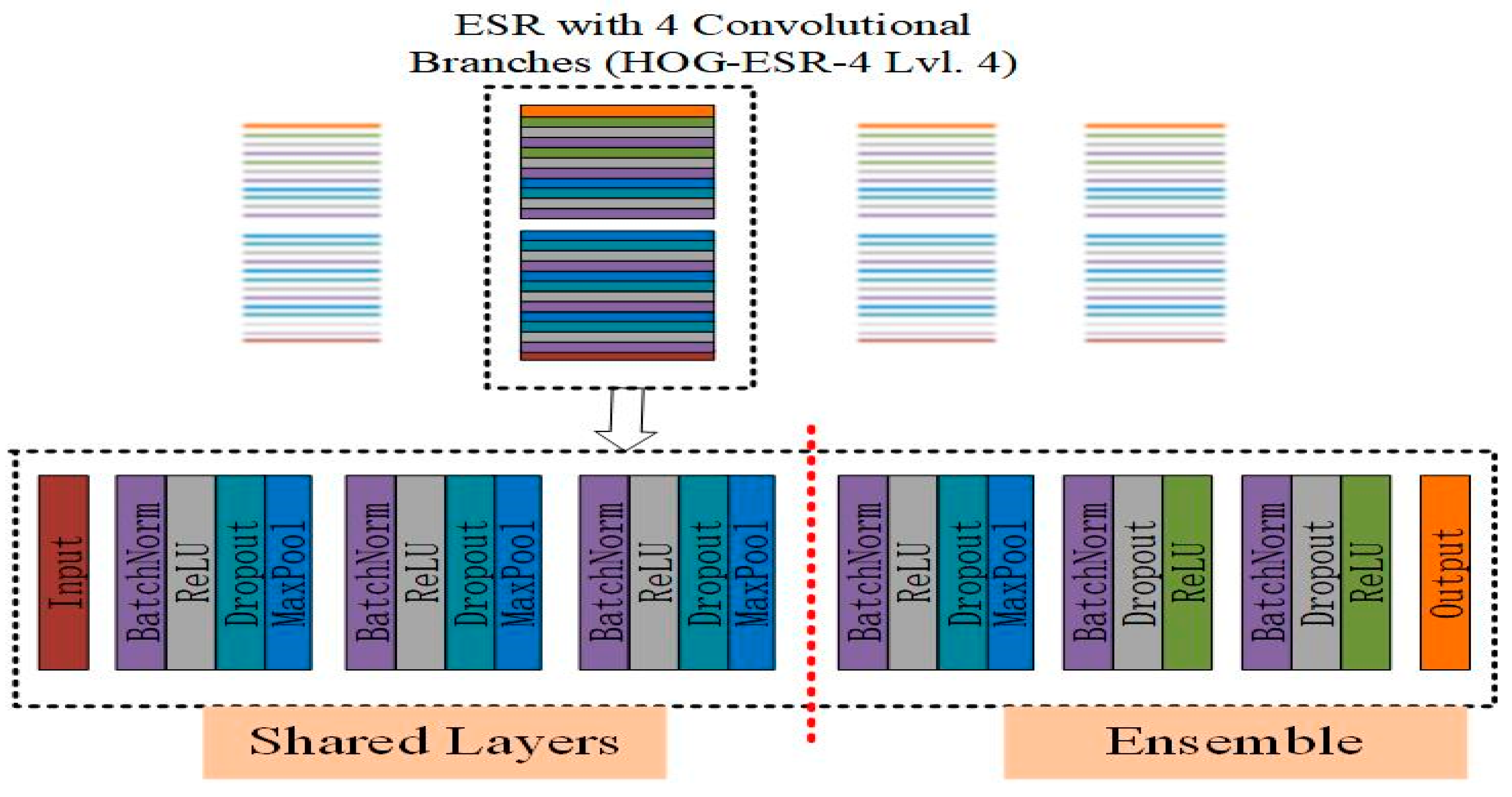
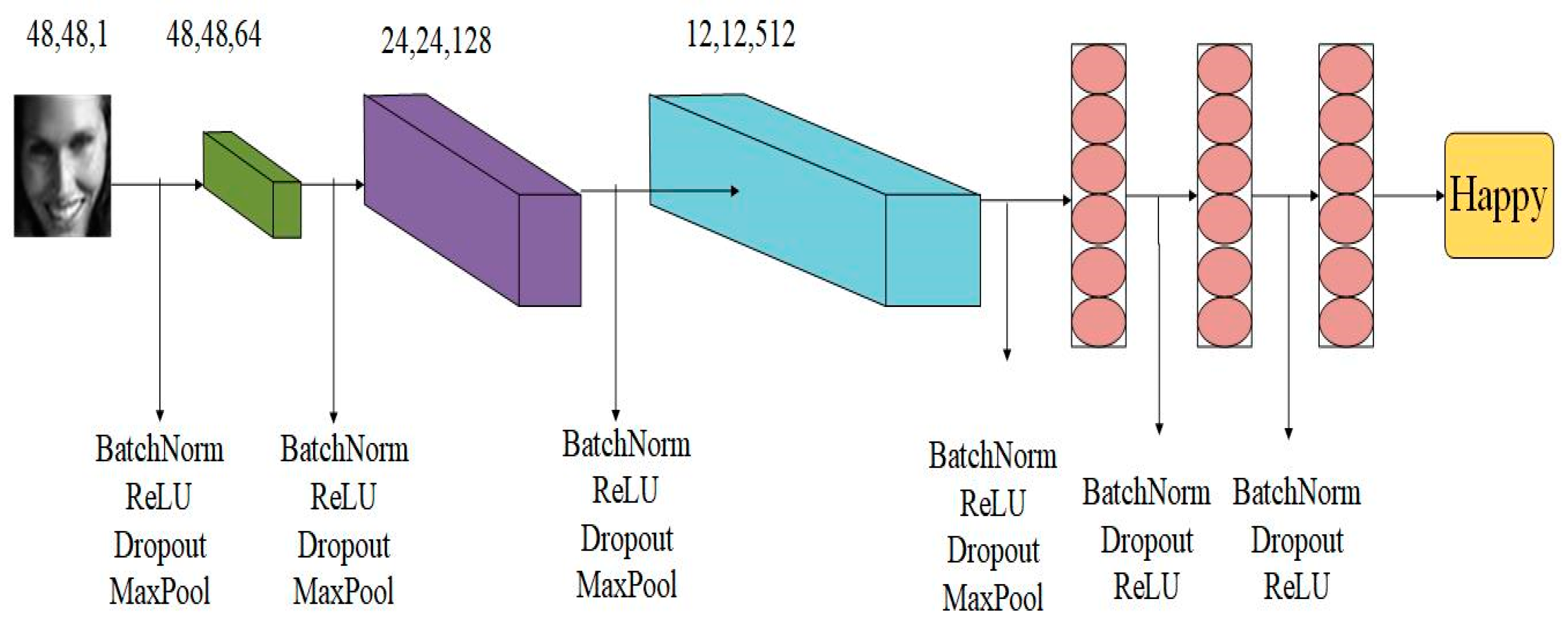
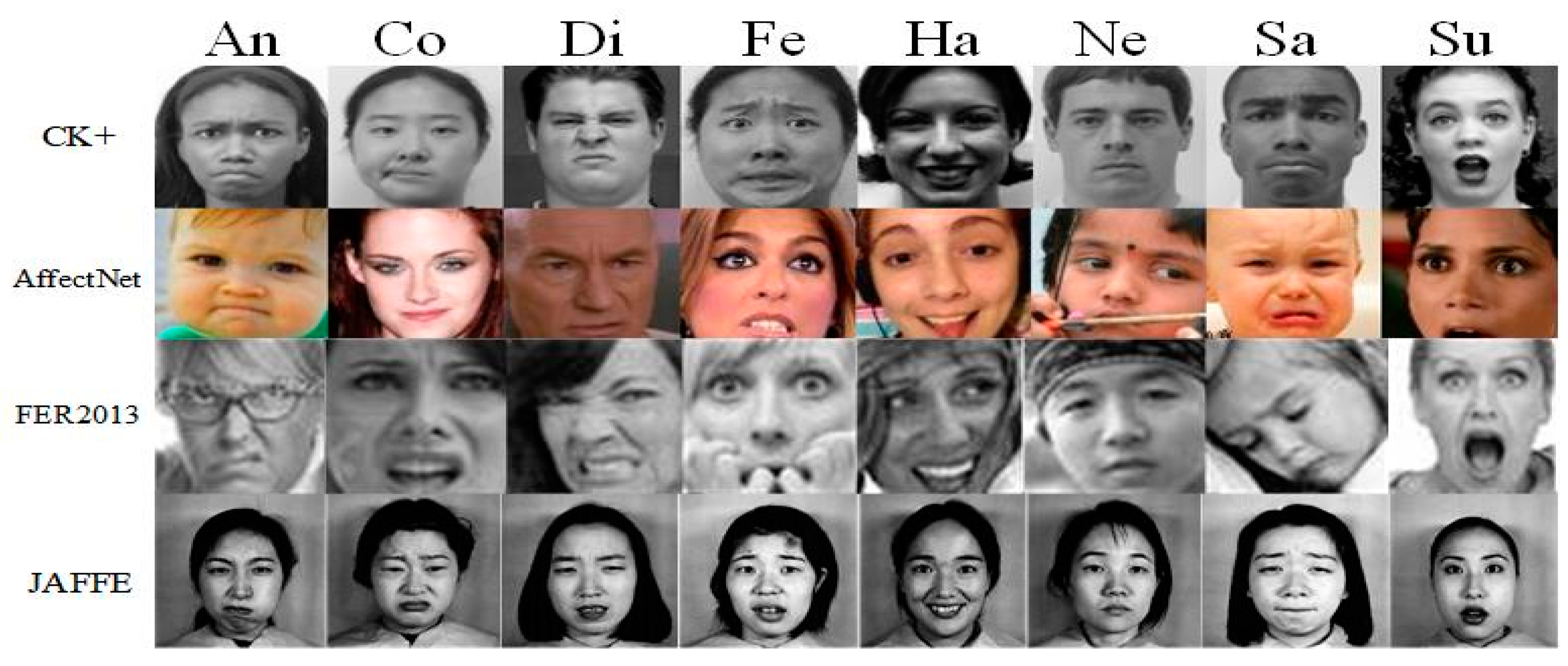

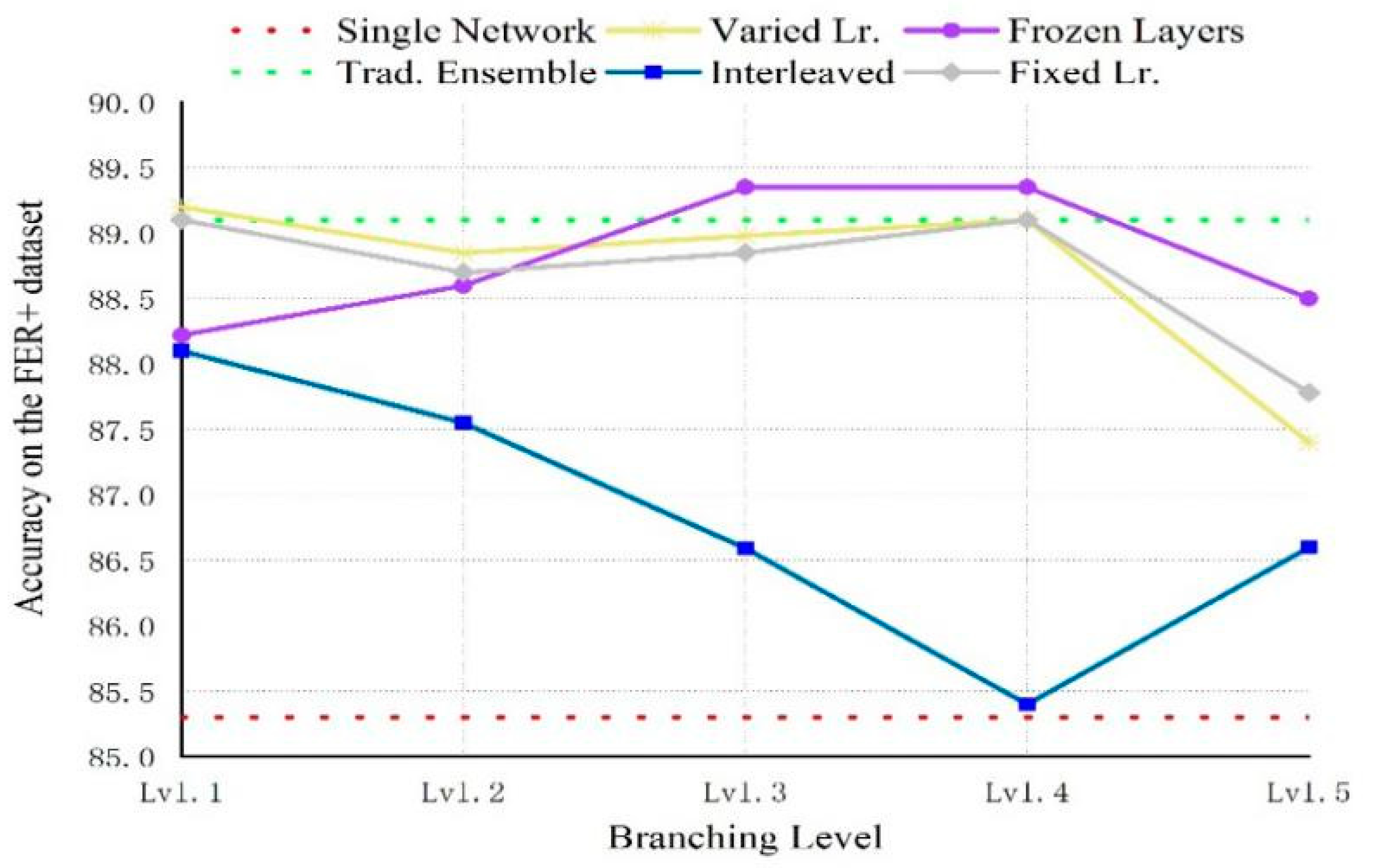
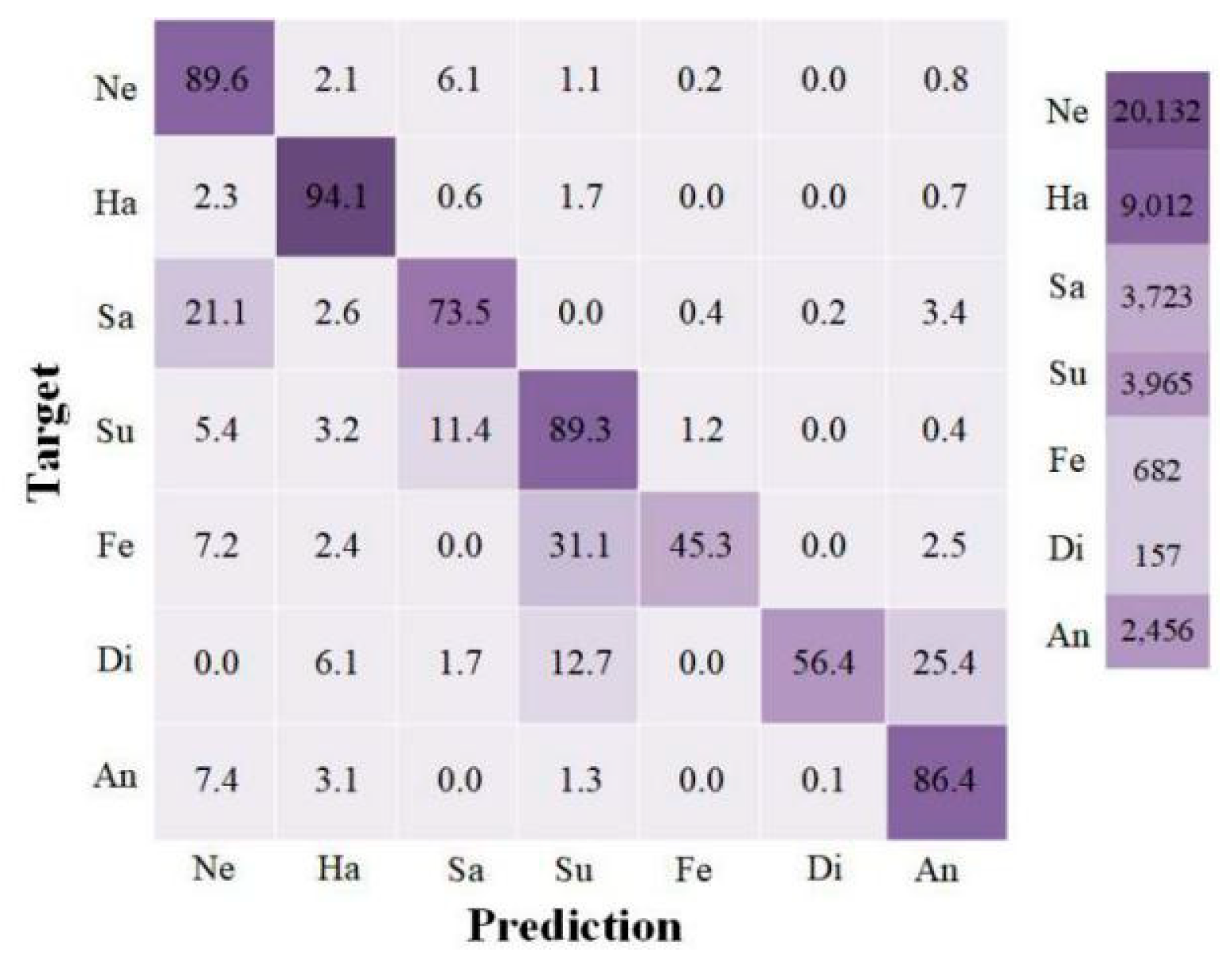
| Parameter | Value |
|---|---|
| Learning Rate | 0.01 |
| Regularization | 1 × 10−7 |
| Hidden Neurons | 256,512 |
| Approach | Year | Accuracy |
|---|---|---|
| TFE-JL [44] | 2018 | 84.3% |
| SHCNN [61] | 2019 | 86.54% |
| ESRs [50] | 2020 | 87.15 ± 0.1% |
| HOG-ESRs | 2020 | 89.3 ± 1.1% |
| Approach | Dataset | Accuracy |
|---|---|---|
| HOG-ESRs | CK+ | 88.3 ± 0.8% |
| JAFFE | 87.9 ± 2.1% | |
| AffectNet | 62.13 ± 0.5% | |
| FER2013 | 89.3 ± 1.1% |
| Approach | # | Accuracy |
|---|---|---|
| Single Network | 140,802 | 85.3 ± 2.1% |
| Traditional Ensemble | 560,328 | 89.1 ± 1.5% |
| HOG-ESR-4 Lvl.4 | 370,411 | 89.3 ± 1.1% |
| HOG-ESR-4 Lvl.5 | 250,005 | 88.4 ± 3.5% |
| Fastest Time | Slowest Time | |
|---|---|---|
| Time | about 830 ms | about 1240 ms |
Publisher’s Note: MDPI stays neutral with regard to jurisdictional claims in published maps and institutional affiliations. |
© 2021 by the authors. Licensee MDPI, Basel, Switzerland. This article is an open access article distributed under the terms and conditions of the Creative Commons Attribution (CC BY) license (http://creativecommons.org/licenses/by/4.0/).
Share and Cite
Zhong, Y.; Sun, L.; Ge, C.; Fan, H. HOG-ESRs Face Emotion Recognition Algorithm Based on HOG Feature and ESRs Method. Symmetry 2021, 13, 228. https://doi.org/10.3390/sym13020228
Zhong Y, Sun L, Ge C, Fan H. HOG-ESRs Face Emotion Recognition Algorithm Based on HOG Feature and ESRs Method. Symmetry. 2021; 13(2):228. https://doi.org/10.3390/sym13020228
Chicago/Turabian StyleZhong, Yuanchang, Lili Sun, Chenhao Ge, and Huilian Fan. 2021. "HOG-ESRs Face Emotion Recognition Algorithm Based on HOG Feature and ESRs Method" Symmetry 13, no. 2: 228. https://doi.org/10.3390/sym13020228
APA StyleZhong, Y., Sun, L., Ge, C., & Fan, H. (2021). HOG-ESRs Face Emotion Recognition Algorithm Based on HOG Feature and ESRs Method. Symmetry, 13(2), 228. https://doi.org/10.3390/sym13020228






